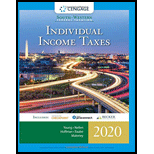
Individual Income Taxes
43rd Edition
ISBN: 9780357109731
Author: Hoffman
Publisher: CENGAGE LEARNING - CONSIGNMENT
expand_more
expand_more
format_list_bulleted
Question
Chapter 16, Problem 2RP
To determine
Discuss how to treat the $600,000 payment on person C’s 2019 tax return.
Expert Solution & Answer
Trending nowThis is a popular solution!

Students have asked these similar questions
Accounting?
Hello tutor please given General accounting question answer do fast and properly explain all answer
I need help with this general accounting question using standard accounting techniques.
Chapter 16 Solutions
Individual Income Taxes
Ch. 16 - Prob. 1DQCh. 16 - An individual taxpayer sells some used assets at a...Ch. 16 - Alison owns a painting that she received as a gift...Ch. 16 - Prob. 4DQCh. 16 - Prob. 5DQCh. 16 - Prob. 6DQCh. 16 - Prob. 7DQCh. 16 - Prob. 8DQCh. 16 - After netting all of her short-term and long-term...Ch. 16 - Prob. 10DQ
Ch. 16 - Near the end of 2019, Byron realizes that he has a...Ch. 16 - Prob. 12CECh. 16 - Prob. 13CECh. 16 - Prob. 14CECh. 16 - On May 9, 2019, Glenna purchases 500 shares of...Ch. 16 - Prob. 16CECh. 16 - Prob. 17CECh. 16 - Elliott has the following capital gain and loss...Ch. 16 - Prob. 19PCh. 16 - Prob. 20PCh. 16 - Prob. 21PCh. 16 - George is the owner of numerous classic...Ch. 16 - Prob. 23PCh. 16 - Prob. 24PCh. 16 - Prob. 25PCh. 16 - Melaney has had a bad year with her investments....Ch. 16 - Prob. 27PCh. 16 - Prob. 28PCh. 16 - Prob. 29PCh. 16 - Prob. 30PCh. 16 - Prob. 31PCh. 16 - Prob. 32PCh. 16 - Prob. 33PCh. 16 - Prob. 34PCh. 16 - Prob. 35PCh. 16 - Prob. 36PCh. 16 - Prob. 37PCh. 16 - Dennis sells short 100 shares of ARC stock at 20...Ch. 16 - Elaine Case (single with no dependents) has the...Ch. 16 - Prob. 40PCh. 16 - Prob. 41PCh. 16 - Prob. 42PCh. 16 - Paul has the following long-term capital gains and...Ch. 16 - Helena has the following long-term capital gains...Ch. 16 - For 2019, Ashley has gross income of 38,350 and a...Ch. 16 - Prob. 46PCh. 16 - For 2019, Wilma has properly determined taxable...Ch. 16 - Prob. 48PCh. 16 - Gray, Inc., a C corporation, has taxable income...Ch. 16 - Harriet, who is single, is the owner of a sole...Ch. 16 - Ashley Panda lives at 1310 Meadow Lane, Wayne, OH...Ch. 16 - Paul Barrone is a graduate student at State...Ch. 16 - Prob. 1RPCh. 16 - Prob. 2RPCh. 16 - Prob. 3RPCh. 16 - Prob. 4RPCh. 16 - Prob. 1CPACh. 16 - Conner purchased 300 shares of Zinco stock for...Ch. 16 - Brad and Angie are married and file a joint...
Knowledge Booster
Similar questions
- ??!!arrow_forwardD E F G H RELATIVE CELL REFERENCES J K L M N A B 1234567 Growth Rate (Expected) Year 0 Year 1 Formulas 4 Investment A 12% $2,200 #N/A 5 Investment B 6 Investment C 1% $2,200 3% $2,200 #N/A #N/A Year 5 Year 6 Year 7 Year 8 Year 9 Year 10 8 "Take each value in column C and multiply it by its adjacent growth rate in column B (which is 1 plus the percentage expected growth)." 9 10 ABSOLUTE CELL REFERENCES 11 12 Growth Rate (Expected) 13 Investment A 12% Year 0 $2,200 Year 1 Year 2 Year 3 Year 4 14 15 Formulas #N/A #N/A #N/A #N/A #N/A 16 #N/A #N/A #N/A #N/A 17 "Start in column D, then move across allowing the column to change, and multiply the preceding value by its FIXED growth rate in cell $B$13 (which is 1 plus the percentage expected growth) to get the current value." #N/A 18 19 FIXED COLUMN / RELATIVE ROW CELL REFERENCES 20 Growth Rate 21 (Expected) Year 0 Year 1 Year 2 Year 3 Year 4 Year 5 Year 6 Year 7 Year 8 Year 9 Year 10 22 Investment A 23 Investment B 24 Investment C 12% 1% 3%…arrow_forwardBrilliant Professor Martin Company has an activity cost pool for inspecting, with an estimated overhead of $240,000. It produces kitchen rugs (2,000 inspections) and bathroom rugs (2,500 inspections). How much of the inspecting cost pool should be assigned to kitchen rugs? Answer thisarrow_forward
- Devlin Investments carries portfolios of both trading securities and available-for-sale securities. At the end of 2021 and 2020, the trading securities were valued at $382.7 billion and $459.3 billion, respectively; and the available-for-sale securities were valued at $173.8 billion and $92.6 billion, respectively. Together, the investments comprise about 30 percent of the company's total assets as of December 31, 2021. Trading securities are carried on the balance sheet at market value. Compute the net decrease in the investment in trading securities during 2021.arrow_forwardi need correct answer for Finanacial accounting questionarrow_forwardWhat amount of gain does he have to report on this sale ?arrow_forward
arrow_back_ios
SEE MORE QUESTIONS
arrow_forward_ios
Recommended textbooks for you
 Individual Income TaxesAccountingISBN:9780357109731Author:HoffmanPublisher:CENGAGE LEARNING - CONSIGNMENT
Individual Income TaxesAccountingISBN:9780357109731Author:HoffmanPublisher:CENGAGE LEARNING - CONSIGNMENT

Individual Income Taxes
Accounting
ISBN:9780357109731
Author:Hoffman
Publisher:CENGAGE LEARNING - CONSIGNMENT



